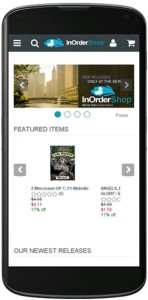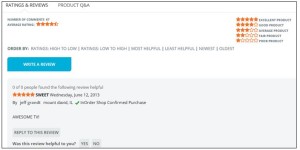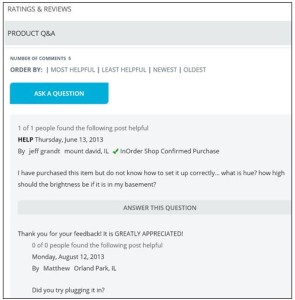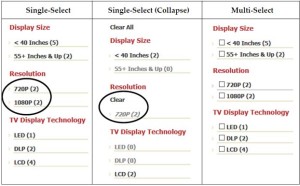Category: eCommerce Shopping Carts
5 Things to Teach Your Competitors about Inventory

Inventory management has come a long way. In today’s fast paced, Internet-connected world, customers are not willing to wait for a product to be “made to order,” and then shipped in six to eight weeks. They expect it much sooner. This creates the need to stock the product in the warehouse so it is available for immediate shipment when an order is taken. When one firm offers rapid delivery by carrying stock, competitors are generally forced to do the same. And so goes the path of improvement for both businesses and consumers. You want your business to be the one in the lead. Here are five lessons you can teach your competitors about inventory.
Lesson 1 – Keep Fill Rates as High as Possible
If stock is depleted from the warehouse, and a customer’s order cannot be filled within a reasonable or requested amount of time, the customer will often cancel the order and then re-order from a competitor that has stock available.
Lesson 2 – Preventing Attrition is Critical
Once a customer switches to a competitor, it may be much harder to get future orders from that inconvenienced customer. You don’t want to lose the repeat customers that you worked so hard to build up over time.
Lesson 3 – Increased Order Cycle Time Increases Shipping and Fulfillment Costs
For customers who are willing to wait out the backorder fulfillment process, shipping and fulfillment costs will be higher, especially if the order requires partial shipments as stock becomes available. Delayed shipment notices may need to be sent to customers, and the liability for unearned cash prepayments with backorders must be tracked. The cost of filling separate backorders may exceed the profit of the original order, and the only remaining argument for filling the backorder will be to prevent customer attrition.
Lesson 4 – Inventory Turnover is Important
Inventory turnover measures the performance of your investment in your inventory. Carrying too much stock in the warehouse puts a burden on an organization’s cash flow, which can easily outweigh benefits that may be offered for “ordering in bulk” in excess of near-future demand. Carrying too much stock on hand also increases the risks of theft, damage, and obsolescence to inventory on hand during long-term storage.
Lesson 5 – Accurately Forecasting Demand is Critical
Obviously, forecasting is vital for keeping your inventory investment as low as
possible without negatively impacting fill rates. The ability to forecast customer demand accurately is advantageous for obvious reasons:
- It improves customer satisfaction.
- Shipping and fulfillment costs are reduced when orders can be shipped complete at once.
- Inventory quantity on hand is more level, which controls costs and reduces the risks associated with carrying excessive inventory quantities.
Demand forecasts developed within the inventory system must be generally consistent with planning numbers generated by the marketing and other departments. However, your ERP system must use inventory forecast methods that are proven most useful with inventory systems, rather than forecasts generated by marketing or budgeting departments. It is important that inventory forecasts be made by SKU, by warehouse location, and by time unit. Merchandising managers may perform SKU forecasting based on demand history, and market managers may perform forecasting based solely on the predicted sales curve of catalogs. If the marketing department is planning an unusually big promotion and expects to sell three million units of an otherwise unpopular product, and the merchandising department forecasts project a total demand of only one million units, senior management must reconcile these very different visions of the future. While you may influence your customers with pricing, catalogs, and promotions, customers ultimately will order what, where, and when they desire.
The heart of an organization’s forecasting success is knowing how customers will order. The best way to control inventory to your advantage is through an ERP system that plans for future actions of your customer base.
Use Your ERP Software to Avoid a “Big eCommerce Short”
 This article compares increasing eCommerce sales to the housing market bubble. It discusses loss of sales in the checkout process that merchants might know about, calling it a new “big short.” The article continues to explain where the sales breakdowns occur, including the checkout process, consumer confidence in the merchant, and how payment declines are handled.
This article compares increasing eCommerce sales to the housing market bubble. It discusses loss of sales in the checkout process that merchants might know about, calling it a new “big short.” The article continues to explain where the sales breakdowns occur, including the checkout process, consumer confidence in the merchant, and how payment declines are handled.
You can use your ERP system to help avoid each of those breakdown points. Using a smart checkout process and your ERP system to its potential, your eCommerce business can provide your customers with a smooth purchase process and the information you need to monitor it. Here are just a few ways to help protect your eCommerce business against abandoned carts:
Checkout process – Keep it simple. Show your shoppers the checkout flow to let them know what to expect. Keep it efficient with as few steps as possible. Giving customers an up-front shipping estimate, or the option to bypass registration (when appropriate) can eliminate some of the breakdown at checkout.
Trust – This is a big deal. Customers don’t want to think about security – they want you to. And if you’re not easy to contact, they may go elsewhere.
It can be complicated for any business to keep up with all the cyber attacks and payment fraud going on around us, but you must be vigilant. Keep up with your PCI DSS requirements, have a security process and an incident response plan, and train your employees on them. A good ERP system can help with features such as fraud scoring, and it will support your PCI DSS efforts to keep your sensitive data safe.
Make sure your customers can reach you immediately with any questions. Display your phone number where it can be easily and quickly seen. If a shopper has a question or problem navigating your site, make sure you can help. Keep Customer Service always at your customers’ fingertips, and make sure your customer service reps can pull up the customer’s shopping cart, edit it, and help the customer get through checkout if necessary.
Payment Declines – This is when knowing your business and your customers is so important. While you can detect patterns that are typical of fraud, you may also be flagging valid transactions, especially if you do business internationally.
Know Your Business – Where are your transactions failing? Put a process in place to check your data regularly, and follow it. Review the tools from your payment gateway(s), Google Analytics, and reports from your ERP system to see what might be causing a problem. And use these suggestions to recover up to 30% of abandoned carts with Email reminders. Use your data to your advantage by making adjustments where they’re needed.
It’s your business; be aware of it. Don’t bet against yourself.
Increase Sales by Soliciting Customer Feedback
It is important to know what your customers think of your products because then you know how you can improve your offerings, and where you should consider raising or lowering prices. Additionally, reviews can increase sales by steering and bolstering confidence as new shoppers are considering a making a purchase.
InOrder lets you review the reviews, edit them when necessary while saving the original, but most importantly, it gives you a chance to discuss and resolve problems with customers who might not otherwise come back next time due to a misunderstanding or a solvable problem. It also lets your reps see a customer’s past reviews and thank the customer, or use their feedback to help make new recommendations.
Regardless of these conveniences, it is vital to keep customers engaged after a sale because then they are more likely to remember your website the next time they are ready to make their next purchase. A perfect way to seal this deal with busy customers is to send an email that offers a small compensation, such as a $5 coupon for customers who submit their first follow-up review to your site. The coupon code can simply be a key code linked to a promotion that allows one-time customer use. InOrder will only allow a discount up to the amount of the purchase.
Sales and Search Results – Opportunities for eCommerce with Responsive Mobile Design
A website with responsive design adjusts to the sizes of all devices shoppers are using, naturally providing optimal presentation. For a web store, the result is a single cart that functions for both PC and mobile, with a similar look and feel, regardless of device size, no longer requiring multiple web sites. This means a better shopping experience for your users, which can translate to more sales and higher search rankings.
The alternatives to responsive design are dynamic serving or maintaining a separate website for mobile shoppers. Dynamic serving uses different HTML for different types of devices, so when users search for information, results for the same site are shared between different versions of HTML. Hopefully, a mobile site using dynamic serving is set up properly; otherwise, Google might not even find the mobile content. Maintaining a separate web store for mobile shoppers is (at least) twice the work as having a single online web store. Each supported device requires a separate web site. Otherwise, it might not display properly to mobile users, increasing the number of people who leave the website after visiting only one page (raising bounce rates), and risking loss of would-be customers to frustration. If your site is awkward for mobile users, you could be decreasing your own search results and sales.
 Responsive design eliminates these concerns. It is more cost-effective and easier to manage than maintaining two separate websites, it uses the same HTML for all devices, and it provides a better experience for users who switch between devices and for those who share links to websites. It is also Google’s recommended design for all devices
Responsive design eliminates these concerns. It is more cost-effective and easier to manage than maintaining two separate websites, it uses the same HTML for all devices, and it provides a better experience for users who switch between devices and for those who share links to websites. It is also Google’s recommended design for all devices
Google can more efficiently index your website if it uses responsive design, and it isn’t necessary to redirect a URL, which doesn’t increase the time it takes to load your website. In addition, responsive design provides a better experience for all users. Font sizes have a consistent appearance, so users don’t have to work hard to see the content (no double-tapping or pinch-to-zoom necessary), and links are large enough for fingers to use accurately.
There is a lot of research to support the decision for responsive design. According to a survey by Signal, 85% of respondents plan to shop using PCs or laptops, 67% plan to browse more from phones or tablets, and 60% plan to buy more from phones or tablets than they did last year. And according to this article, 75% of adult internet users have two or more devices for online use, and 67% switch between devices them, so responsive design is a sound business decision.
For details about InOrder’s responsive mobile design, or for a demo of InOrder eCommerce, contact Morse Data Corporation.
eCommerce Experience is Important to Business Customers
eCommerce companies seem to be realizing more and more that their business customers appreciate the convenience of online shopping just as much as retail customers do.
While potential new business customers might not respond to “Call for Pricing” messages on your web site, they may be more likely to order when the pricing information is readily available. And they want other conveniences, like quick search results, pictures, and descriptions. They want easy reordering and if products are backordered, they need to know when to expect them. And once they log in to an established web account, they want personalized services, like the ability to see their negotiated prices and discounts applied as they shop on-line, with a presentation relevant to them.
B2B companies using eCommerce are making sure they don’t miss out on opportunities to grow their business. They can choose to add multiple customer bases to their eCommerce businesses – for example – direct consumers, or businesses in other countries.
If you are ready to grow your B2B on-line business, consider InOrder. With its central database and the ability to offer on-line integrated real-time inventory, InOrder can help manage and keep product information accurate and consistent for multiple customer bases. The days of having a separate computer system for each channel are long gone!
Contact us to request a demo showing how InOrder can help you attract new business.
Does Your ERP Software Embrace Your Comparison Shoppers?
People research products. As shoppers, we check out all our options. We gather information about what’s available, we read reviews, and then we decide where to shop.
Shoppers want to know what they’re buying before they buy it. They want to know if they’ll like a product, how it works, and what others think about it. They also want to know about you. They need to know that their information is safe with you and that their purchases will arrive quickly and without incident. They look for opinions before they shop, while they’re shopping, and when they’re finished, they tell others all about the product and their shopping experience.
Motivate shoppers to use your website for researching your products and make it easy for them to buy from you by providing what they need.
Build confidence and trust
Add a social aspect to your website that keeps your shoppers involved. Keep them engaged with Ratings, Reviews, Comments, and Q&A. Reply to feedback, add comments to a thread, encourage questions, and offer suggestions.
 Further engage your customers with the InOrder Email Communications Enhancement. Thank them for their purchases, and invite them to rate the products they purchased or add their comments.
Further engage your customers with the InOrder Email Communications Enhancement. Thank them for their purchases, and invite them to rate the products they purchased or add their comments.
Set up a page of FAQs about your products, with answers for information purposes. You can also provide a place for your customers to ask questions with answers contributed by your experts or other customers.
With full control over feedback, you can allow customers to post directly to your website, or you can approve or edit reviews and comments before publishing them.
Increase participation
Interact with your shoppers and help keep them involved in the shopping experience.
 You can even create a community where shoppers can share information and ideas about your products. There are many ways to encourage participation in your web store community. Here are some examples:
You can even create a community where shoppers can share information and ideas about your products. There are many ways to encourage participation in your web store community. Here are some examples:
If you sell parts for antique cars, you can start a thread about local car shows and invite customers to post pictures of their cars with your parts.
If you sell fishing equipment, you can define a forum about fishing equipment and start a thread about fishing lures. Or, explain different types of fishing poles and what type of fishing each are used for, such as ice fishing, or salmon fishing, etc. Invite customers to post pictures of fish they caught with your products.
Forums, FAQs, and other community pages can be created at the category level, or they can be created at the product level so you can have details specific to a product.
Rather than outsource these features, implement them with InOrder’s built-in functions that tie your products with reviews and your customers, keeping the details all in one place so you don’t have to maintain it in separate systems. All this participation also contributes to your search content. When shoppers search for reviews and find your site in their search results, your website has a better chance of being seen. Shouldn’t your website be the one they go to for trusted information – and final purchase – when making informed decisions?
Good ERP Systems have everything you need to run your business. From ordering your inventory, to setting up your web store, to taking and processing orders, to paying your bills, and so much more. Make sure you’re using it to its fullest potential – and to yours.
For more information about InOrder, contact Morse Data Corporation.
Coming Soon: New InOrder User Interface
The Morse Data Development Team has released details about a new project (code name “Dynasty”), which will migrate InOrder into a web-based user interface with .NET.
The new programs will expedite the development process, improve usability for our clients, and enhance portability of the software. This furthers our on-going vision of enhancing the user experience, and it enables an expedited development process by using the same technologies that currently exist in our RF application and our responsive mobile cart.
Dynasty features the ability to re-size any windows, support for CSS-based interface customization, and the ability to run InOrder on any browser-enabled device.
This is the third system re-write by Morse Data in over 40 years, but this one is different because it enables us and our InOrder users to fully leverage their existing InOrder investment. The database tier and the logic tier are rock-solid, and already take advantage of the latest capabilities offered by SQL Server 2014, such as AlwaysOn Availability Clustering. This rewrite only affects the user interface tier, which is being completely re-built to take advantage of the latest object programming platforms and techniques that were not available when the desktop client was initially developed.
The Dynasty rollout will occur in phases, beginning with warehouse components to compliment the recently-completed web-based InOrder RF Interface. The phased release schedule will begin mid-2016, with completion expected in 2017. This rollout will be released to existing InOrder customers as updates become available. The new interface will initially overlap with capabilities of the existing client/server based desktop programs, which will be replaced when functional equivalence is achieved.
Morse Data’s Mobile Web Uses Google’s Recommended Responsive Design
InOrder’s eCommerce module has been enhanced with a responsive design for mobile web using Google’s recommended responsive design pattern. This means that InOrder’s eCommerce web site adjusts to the sizes of all devices customers are using, naturally providing optimal presentation. A single cart functions for both PC and mobile, with a similar look and feel, regardless of device size, no longer requiring multiple web sites. This also means that your InOrder web site won’t be severely penalized in search results for not meeting Google’s responsive design recommendations.
 InOrder’s mobile cart rated 100/100 for user experience according to Google’s ratings, and 91/100 for speed, which compared competitively better than Amazon (70/100), and another website using Magento’s web cart (52/100).
InOrder’s mobile cart rated 100/100 for user experience according to Google’s ratings, and 91/100 for speed, which compared competitively better than Amazon (70/100), and another website using Magento’s web cart (52/100).
Customers with the InOrder eCommerce Module, the InOrder Mobile Cart add-on license, and Web Cart Upgrade Service will automatically receive this new version in time for the holiday shopping season. Other new features include image zoom, and easy linking to favorite social media sites (Facebook, Twitter, LinkedIn, GooglePlus, YouTube, Pinterest, Instagram, Yelp, RSS feed, and your own blog) so your customers can spread the word about your new site.
Contact Morse Data today for a demo of all the newest features.
If You Don’t Know How Your Customers Shop, They May not Find Your Products
We know that if shoppers can’t quickly find what they are looking for on your website, you may as well not offer it, because they will often just give up looking for it, or worse – they will go elsewhere. Giving your customers more options may help them find your products faster.
Web store searches are usually designed by product hierarchy, which is a popular setup. Items are grouped into levels that open as you click to drill-down further. The problem with this is that it’s like going from one room to the next – you usually have to backtrack to enter different rooms. With searches that are designed by product hierarchy, a shopper must keep returning to the “front door” to start looking for the next product.
Your shoppers can find items faster if you provide them with the ability to combine any different criteria, in whatever combinations they choose (even including that hierarchy). This concept is called “Facet Filtering.”
Facet Filtering helps customers fine-tune their search results as they search. Shoppers can make additional selections within current search results based on their individual interests, eliminating the need to sift through too many results all at once. It provides a lot of power for minimal setup.
An example of a search facet can be anything such as color group, size, manufacturer, price range, or whether or not a special feature is included.
Different Facet Types may be used: Single Select, Single Select/Collapse, and Multi-Select. When Single Select is used, facets appear on the website as links. Only a single facet may be selected per category. When Single Select/Collapse is used, facets appear on the website as links. Only a single facet (subcategory) may be selected per category. When a selection is made, the facet list collapses to only show the selected facet. With Multi-Select, facets appear on the website as checkboxes. Multiple facets may be selected for each category.
Rather than limiting your customers, give them as many ways to shop as possible and let them decide. Then check your analytics – use your InOrder reports and Google Analytics – to learn how your customers shop. InOrder’s superb flexibility allows modifications on the fly, so you can set up products to match how shoppers are searching for them.
Our most notable feedback from merchants using InOrder’s Facet Filtering on their website? Customers frequently searching for products starting with unexpected facets, such as Manufacturer rather than starting with a basic product category. As it turns out, customers often have their own plan they want to follow, and will be more likely to buy what they need on your website if it is flexible enough to let them follow that initial plan.
Finally, accommodating customers’ plans to find their first item will shorten their initial “Add to Cart” times. But customers also can get frustrated if their direct path to the next item they need requires “starting over.” Can they easily edit existing facet filters after placing an item in their cart? If they spent several minutes building a filtered list and now they need three more items from that list, can they add them all or do they need to rebuild the list three more times? Better yet, can they tweak the existing list if needed, without restarting it from the beginning? Check your analytics here as well, to confirm there are no patterns of extra steps they had to take to get to the next item, vs. steps they took on their own due to actual browsing.
With this approach, your abandon rates will be lower than ever, but more importantly, your eCommerce revenue will be better than ever.
6 Reasons Why InOrder is Ideal for eCommerce
You already know that InOrder is a high-end enterprise management system with functions found in systems that cost thousands more. With real-time inventory and order tracking, a single database to keep all of your information in one place, InOrder also integrates with everything you need to manage your business.
Here are 6 reasons why InOrder is ideal for attracting new customers and keep them coming back to your online store.
1. Product Browsing Features
A search engine optimized design, allowing additional edge over the competition. InOrder supports mobile browsing (and shopping), graphics, dimensioned inventory, item personalization, and Facet Filtering. AddThis allows your web customers to share pages from your website on social media websites.
2. Product Pricing Features
Extended price breaking information, reflecting special prices and most discount scenarios, is shown as customers add inventory to the shopping cart. InOrder’s eCommerce module also supports volume discounts, wholesale ordering, and special offer-driven pricing and promotion line items. International shopping is also supported, allowing customers to view prices in their preferred currency.
3. Shopping Cart Features
InOrder’s eCommerce shopping cart provides flexible login for customers, including soft logins, which allow web customers to be remembered across shopping sessions, guest checkout, and pre-login requirement option based on owner.
Customer acquisition cookies are supported, as well as open order resume cookies with expiration timer to clean up abandoned carts.
You can keep your customers informed with shipping charge computations, estimated shipping, estimated number of days for delivery, and rate shopping. When real-time stock allocation is used, backorder notifications are presented as items are added to the shopping cart.
4. Checkout and Payment Features
Ship via and payment pages may be skipped to support one-click checkout. Customers may always return to add or edit information on these pages. InOrder’s eCommerce module supports many forms of payment, including:
- Gift cards and gift certificates
- PA-DSS credit card processing, including the re-use of saved credit cards
- PayPal
- Installment payments
- COD
- Saved payment methods
- Cash payments
- Intranet/inter-department orders by G/L account with budget tracking
- Purchase orders
- Credit memo application to new orders
Real-time address verification using calls to your InOrder Address Validation interface subscription enhancements, as well as tax computation interfaces, are supported.
5. Customer Account Features
InOrder eCommerce provides full support for multiple ship-to addresses, browsing history, address books that can be maintained by Customer Service Representatives, and support for multiple customers using the same Email address. Give your customers the best features with control over their own information. Here is a list of what they can do:
- Check gift card balances and loyalty point history
- Set Email preferences to improve deliverability
- Sign up for back-in-stock notification when an item is out of stock
- Check order history and real-time order status
- Repeat orders for seasonal gift reordering
- Manage their address books
- Set payment methods and preferred payment method
- Add feedback, ratings, product Q&A
- Set ordering preferences
- Request catalogs; sign up for mailing lists & interest groups
- List subscriptions, continuity series, standing orders, and memberships
- Maintain Wish Lists
6. Marketing Features
Marketing is crucial to the support and growth of your business, and there is a lot involved. From the way you display your products to measuring the success of your efforts, InOrder eCommerce has what you need.
- URL specification of owner/order class/click-through ad promotion key code
- Navigation bar with special promotions that are displayed based on inventory browse criteria and customer purchase history. Promotions continue randomly throughout the checkout process.
- Loyalty Programs and promotional shipping charges
- Support for the Simple Fade Slideshow plug-in.
- Multiple item relationships for additional cross-selling and up-selling opportunities
- Multiple carousel displays on home page for different types of cross sells
- Display and selection of related items, including:
- Items related to items in the cart
- Items related to the current item
- Items from the customer’s Wish List
- Items other customers bought
- Items related to previous purchases
- Items related to/replacing a discontinued item
- Items related to a discontinued hierarchy
- Integration with the InOrder Email Marketing Enhancement and the Email Communication Enhancement.
For more information about eCommerce with InOrder, contact sales@morsedata.com.






